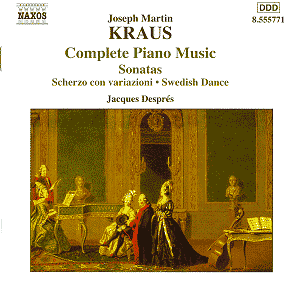Joseph Martin Kraus
was a man of many talents. He received
a broad education, not only in music,
but also in law, jurisprudence and philosophy.
In the 1770s he published a collection
of poems and later became acquainted
with a ‘Sturm und Drang’ literary circle
in Göttingen. In 1778 he accompanied
a Swedish student to Stockholm and then
tried to establish himself as a composer.
It wasn’t easy to obtain
an official position. He was active
as a conductor and writer about music.
In the 1780’s he began to see some success,
as he was elected as member of the Royal
Academy of Music. In 1782 King Gustavus
III sent him on a Grand Tour through
Europe, which brought him to Germany,
Austria, Italy, France and England.
Famous colleagues, like Haydn and Gluck,
held him in high esteem. Kraus himself
declared his admiration for Gluck as
well as Grétry.
Today Kraus is mainly
known for his symphonies; some of his
chamber music and a couple of dramatic
works have also been recorded.
This is the first recording
of Kraus’s complete keyboard works.
He wasn’t a professional keyboard player,
which may explain the rather small output
in this genre. It is known, however,
that some keyboard works have been lost.
The keyboard pieces
are quite different in character. "His
overriding compositional premise was
the infusion of drama into all genres
of music, a notion that stems from his
contact with the literary ‘Sturm und
Drang’ ", writes Kraus scholar
Bertil van Boer in the article on Kraus
in the New Grove (he also wrote the
liner notes in the booklet). That sense
of drama is most obvious in the two
sonatas. The fast movements are bold
and imaginative and harmonically often
surprising, whereas in the adagio of
the Sonata in E we meet the influence
of Carl Philipp Emanuel Bach and the
‘Empfindsamkeit’.
Themes with variations
were very popular in the second half
of the 18th century, and Kraus seems
to have liked them particularly: not
only the Scherzo con variazioni, but
also the opening Rondo in F and the
Swedish Dance belong to that genre.
And both sonatas contain an ‘andante
con variazione’.
Quite peculiar are
the ‘Zwei kuriose Minuetten’ which close
the recording. "According to the
sole source, it was written in 1780
as a musical joke and sent to J. S.
Bach’s biographer, Johann Nikolaus Forkel,
with whom Kraus had debated the merits
of early music when he was in Göttingen"
(Bertil van Boer in the liner notes).
The first menuet is a parody of a menuet
from the ‘Notenbüchlein vor Anna
Magdalena Bach’. The second one contains
deliberate compositional errors to portray
an incompetent composer.
This is a very interesting
recording, but unfortunately it is a
missed opportunity as far as the interpretation
is concerned: the wrong instrument is
used. A modern concert grand is not
the right tool to reveal the true character
of Kraus’s keyboard music.
One of the problems
is dynamics. In some pieces – the Rondo,
for instance - Després holds
back the dynamic contrasts the music
requires. As a result these pieces become
banal and superficial. In the sonatas
he uses the full dynamic possibilities
of the instrument, but here it sounds
overdone and exaggerated.
The balance between
the voices is not ideal. In the Swedish
Dance, for example, the repeated motifs
in the left hand are often overpowered
by the right hand. In particular in
the adagio from the Sonata in E the
lack of subtlety of the piano is almost
painful: the sensitive character of
this movement, with its many unexpected
twists and turns, goes out the window
in this performance.
The range of colouring
of the fortepiano would have been very
useful to differentiate between the
four sections of the Rondo in F. The
strange thing is that, according to
the booklet, Jacques Desprès
is experienced in playing the fortepiano.
Then why did he choose an instrument
which fits in badly with the music?
Johan van Veen
